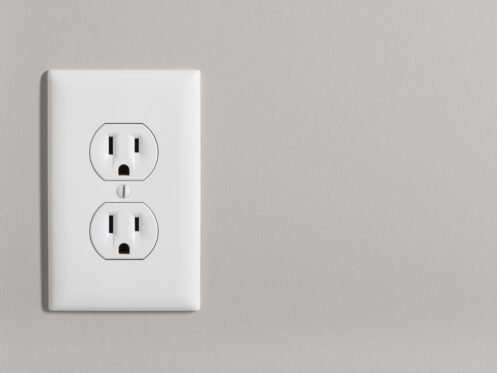We use electricity every day, but we rarely dwell on its inherent risks. The energy that fuels our convenience, comfort, and entertainment can also be dangerous. Fortunately, there are steps you can take to minimize some of the risks. Having your electrical outlets grounded can protect your property.
Grounded vs. Ungrounded Outlets
There are two types of electrical outlets: grounded and ungrounded. You can visibly tell the difference between the two types. Ungrounded outlets can only receive two-prong cords. An ungrounded outlet only has two vertical slots. In contrast, a grounded outlet can accommodate a three-prong cord. A grounded outlet has two vertical slots and a round opening just beneath the two slots.
Grounded Outlets
The differences between grounded and ungrounded outlets extend beyond appearance. The electrical outlets in your home have two main wires. There is a black wire, which is also known as the hot wire. Your outlets also have a white wire, which is commonly referred to as the neutral wire.
Grounded outlets have a third wire that connects the electrical circuit to the ground. The third wire on a grounded outlet directs excess electricity to the ground during an electrical accident. Redirecting dangerous electricity to the ground prevents the current from harming people and surrounding property.
Ungrounded Outlets
Ungrounded outlets only have a black wire and a white wire. They do not have a third grounding wire. Therefore, ungrounded outlets do not provide an escape route that sends excess current to the ground. Although ungrounded outlets are inherently unsafe, an electrician can minimize the risk.
Homes built before the 1960s are less likely to have electrical grounding in place. Over time, local building codes have phased out ungrounded outlets to improve building safety. Nevertheless, some homes are still not up to modern building codes. It is also important to know that looks can be deceiving. Some outlets may appear to be grounded because they have three prongs. However, a look behind the outlet cover reveals that there are only two wires. Consult a licensed electrician to determine whether your home has ungrounded outlets.
Changing Your Home’s Outlets
Although it is possible to upgrade ungrounded outlets and change them to grounded, you should leave the work to an electrician. Grounding an ungrounded outlet requires the installation of a wire to connect the outlet to a grounding system. Your electrician will evaluate your home’s outlets to confirm the types of outlets you have. After upgrading your outlets, the electrician will perform tests to ensure function and safety.
Examining the Dangers of Ungrounded Outlets
Electricity runs through the wires in your home’s electrical circuit as negative and positive charges. Within the circuit, the electricity is always inclined to discharge its negative energy to return to a balanced state. In most cases, the current returns through the neutral white wires. However, if the outlet is not grounded, the current can become attracted to other materials. The current may flow to materials like wood, pipes, flammable materials, and, in some cases, people. If the excess current reaches material outside of the circuit, the result is generally property damage or injury.
Ungrounded outlets are especially unsafe because they can cause damage or injury even when used properly. Every type of electrical outlet draws a substantial amount of electrical current. Therefore, any outlet can become overloaded. In the absence of a ground wire, overloaded outlets can result in:
- An electrical fire
- Electrical shock or electrocution to humans
- Damage to electrical appliances and other property
Ungrounded Outlets and Short Circuits
A short circuit occurs if electricity travels along an unintended path with little or no resistance. A lack of resistance allows too much electricity to flow through the circuit. There are two types of short circuits: a normal short circuit and ground fault short circuit. A normal short circuit occurs when a hot wire touches a neutral wire. An immediate decline in resistance allows the electricity to move through the unintended, shorter path.
A ground fault short circuit occurs when a hot wire touches the grounded section of a circuit. The grounded portion may be in an outlet, electrical box, appliance, or a bare ground wire itself.
Signs of a Short Circuit
Most homeowners know the most common signs of a short circuit: an appliance shuts off or the circuit breaker trips. A short circuit may seem like an inconvenience, but it can also be dangerous.
Short circuits are especially dangerous if you’re handling an appliance that is plugged into an ungrounded outlet. If you are touching the appliance when a circuit shorts, the electrical current can travel through your body. An electrical current that travels through the body can cause shock, burns, or even death. Homeowners should always consult a licensed electrician instead of doing electrical work on their own.
Common Causes of Short Circuits
Homeowners who are not in a hurry to ground their outlets commonly think electrical accidents are unlikely. Nevertheless, short circuits can have surprisingly common causes.
Worn electrical wires are more susceptible to short circuits. If you notice looseness or a spark when you use an outlet, the outlet may be at risk. Sometimes, you may not be aware of the hazard. For example, a product that has a manufacturing defect can short circuit despite being in good condition. Using electrical devices in the kitchen, bathroom, or otherwise near water also increases the risk of a short circuit. With so much potential for an accident to happen, grounding your outlets is the safest option.
Methods of Grounding an Outlet
There is more than one way to protect your electrical system by grounding your outlets. Each method achieves the same objectives: to protect your property and the people inside.
Rewiring your entire home can be expensive. As a trade-off, doing so will allow you to know the condition of all of your wiring. Not only can you identify ungrounded outlets, but you can also have worn and frayed wires replaced.
Installing a ground-fault circuit interrupter is another option. If you are purchasing a home that has ungrounded outlets, GFCIs are more cost-efficient. You can install a GFCI breaker or install individual GFCIs at each outlet.
Glendale’s Trusted Electrical Contractor
Christian Brothers Air Conditioning Plumbing Electrical has served the Glendale and the Greater Phoenix area for more than 30 years. As much as we value your business, we genuinely prioritize your safety and comfort. Our commitment to customer service has led us to become one of Glendale’s top electrical contractors. When you contact us, you can always expect up-front pricing and honest, competent service.
Our team of licensed electricians has the knowledge and training to keep your home safe and energy efficient. In addition to electrical outlet upgrades, we can do repairs and install surge protectors and electrical panels. If you have an EV, we can install a home charging station for you.
The professionals at Christian Brothers Air Conditioning Plumbing Electrical are also qualified to provide a variety of other home services. We employ licensed plumbers and HVAC technicians. You can count on us for heating and cooling repair, maintenance, and installation. Our plumbers can install water heaters and water filtration systems and service drains and sewers. We are your one-stop shop for many of the conveniences and indoor comforts you enjoy at home.
If you believe it may be time to upgrade your home’s electrical outlets, our experts will give you an honest opinion. Call Christian Brothers Air Conditioning Plumbing Electrical to learn more!










